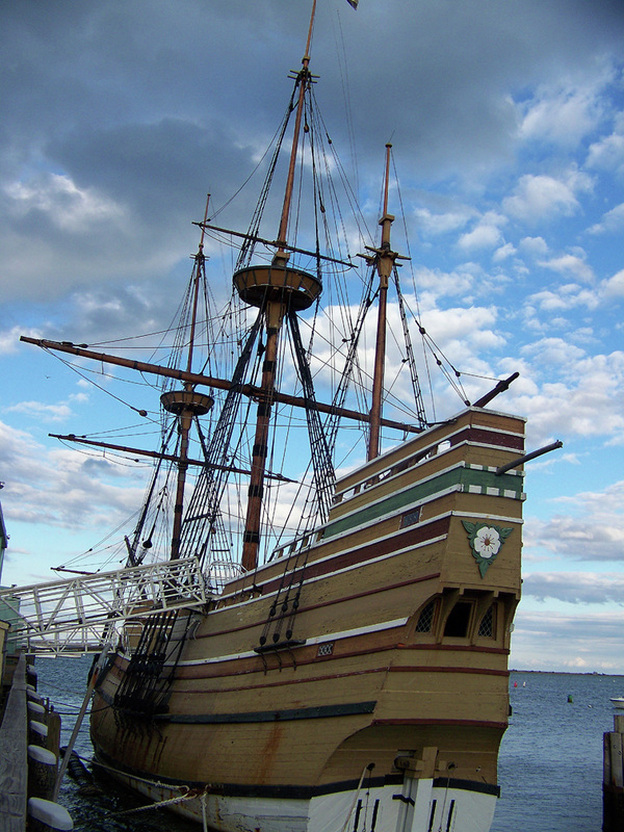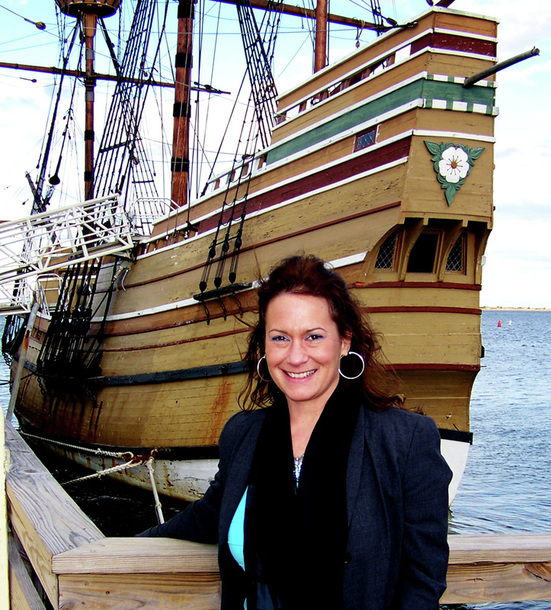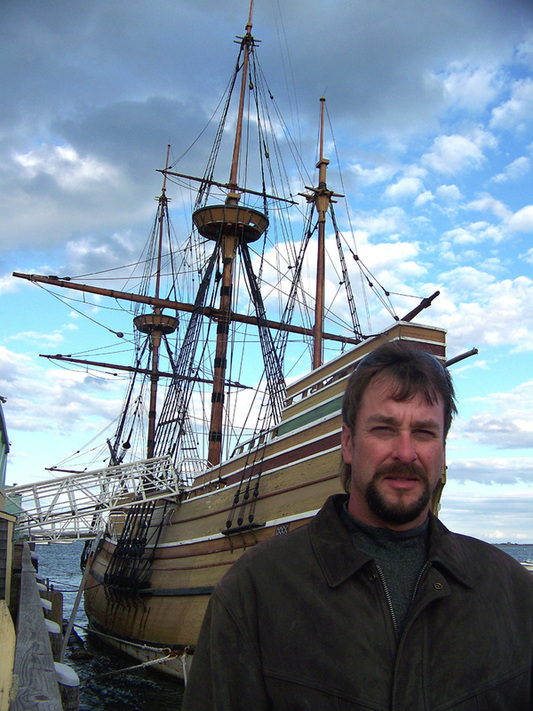The Mayflower

Mayflower From Wikipedia, the free encyclopedia
Tonnage: 180 Crew: 25–30 The Mayflower was the ship that transported the English Separatists, better known as the Pilgrims, from a site near the Mayflower Steps in Plymouth, England, to Plymouth, Massachusetts, (which would become the capital of Plymouth Colony), in 1620.[1] There were 102 passengers and a crew of 25–30.
~ The Mayflower ~ Issue of 1920, 300th anniversary. The vessel left England on September 6, 1620 (Old Style)/September 16 (New Style),[2] and after a grueling 66-day journey marked by disease, which claimed two lives, the ship dropped anchor inside the hook tip of Cape Cod (Provincetown Harbor) on November 11/November 21.[1] The Mayflower was originally destined for the mouth of the Hudson River, near present-day New York City, at the northern edge of England's Virginia colony, which itself was established with the 1607 Jamestown Settlement.[3] However, the Mayflower went off course as the winter approached, and remained in Cape Cod Bay. On March 21/31, 1621, all surviving passengers, who had inhabited the ship during the winter, moved ashore at Plymouth, and on April 5/15, the Mayflower, a privately commissioned vessel, returned to England.[1] In 1623, a year after the death of captain Christopher Jones, the Mayflower was most likely dismantled for scrap lumber in Rotherhithe, London.[4]
The Mayflower has a famous place in American history as a symbol of early European colonization of the future US. With their religion oppressed by the English Church and government,[5] the small party of religious Puritan Dissenters who comprised about half of the passengers on the ship desired a life where they could practice their religion freely. This symbol of religious freedom resonates in US society and the story of the Mayflower is a staple of any American history textbook. Americans whose roots are traceable back to New England often believe themselves to be descended from Mayflower passengers.
The main record for the voyage of the Mayflower and the disposition of the Plymouth Colony comes from William Bradford who was a guiding force and later the governor of the colony.
Mayflower arrived inside the tip of Cape Cod fishhook, 11 November/21 November 1620 (satellite photo, 1997) Contents[hide]
Tonnage: 180 Crew: 25–30 The Mayflower was the ship that transported the English Separatists, better known as the Pilgrims, from a site near the Mayflower Steps in Plymouth, England, to Plymouth, Massachusetts, (which would become the capital of Plymouth Colony), in 1620.[1] There were 102 passengers and a crew of 25–30.
~ The Mayflower ~ Issue of 1920, 300th anniversary. The vessel left England on September 6, 1620 (Old Style)/September 16 (New Style),[2] and after a grueling 66-day journey marked by disease, which claimed two lives, the ship dropped anchor inside the hook tip of Cape Cod (Provincetown Harbor) on November 11/November 21.[1] The Mayflower was originally destined for the mouth of the Hudson River, near present-day New York City, at the northern edge of England's Virginia colony, which itself was established with the 1607 Jamestown Settlement.[3] However, the Mayflower went off course as the winter approached, and remained in Cape Cod Bay. On March 21/31, 1621, all surviving passengers, who had inhabited the ship during the winter, moved ashore at Plymouth, and on April 5/15, the Mayflower, a privately commissioned vessel, returned to England.[1] In 1623, a year after the death of captain Christopher Jones, the Mayflower was most likely dismantled for scrap lumber in Rotherhithe, London.[4]
The Mayflower has a famous place in American history as a symbol of early European colonization of the future US. With their religion oppressed by the English Church and government,[5] the small party of religious Puritan Dissenters who comprised about half of the passengers on the ship desired a life where they could practice their religion freely. This symbol of religious freedom resonates in US society and the story of the Mayflower is a staple of any American history textbook. Americans whose roots are traceable back to New England often believe themselves to be descended from Mayflower passengers.
The main record for the voyage of the Mayflower and the disposition of the Plymouth Colony comes from William Bradford who was a guiding force and later the governor of the colony.
Mayflower arrived inside the tip of Cape Cod fishhook, 11 November/21 November 1620 (satellite photo, 1997) Contents[hide]
-
// [edit] Ship The Mayflower was used primarily as a cargo ship, involved in active trade of goods (often wine) between England and other European countries,[6][7] (principally France, but also Norway, Germany, and Spain). At least between 1609 and 1622, it was mastered by Christopher Jones, who would command the ship on the famous transatlantic voyage, and based in Rotherhithe, London, England.[1] After the famous voyage of the Mayflower, the ship returned to England, likely dismantled for scrap lumber in Rotherhithe in 1623, only a year after Jones's death in March 1622. The Mayflower Barn, just outside the Quaker village of Jordans, in Buckinghamshire, England, is said to be built from these timbers, but this is likely apocryphal.[8]
Details of the ship's dimensions are unknown, but estimates based on its load weight and the typical size of 180-ton merchant ships of its day suggest an estimated length of 90–110 feet (27.4–33.5 m) and a width of about 25 feet (7.6 m).[6]
The ship had a crew of twenty-five to thirty,[7] along with other hired personnel; however, the names of only five are known, including John Alden.[7] William Bradford, who penned our only account of the Mayflower voyage, wrote that John Alden "was hired for a cooper [barrel-maker], at South-Hampton, where the ship victuled; and being a hopefull yong man, was much desired, but left to his owne liking to go or stay when he came here; but he stayed, and maryed here."[9]
[edit] Pilgrims' voyage The Mayflower Memorial in Southampton. For more details on acquisition of the ship and the planning of the voyage, see Pilgrim Fathers. Initially, the plan was for the voyage to be made in two vessels, the other being the smaller Speedwell, which had transported some of the Pilgrims embarking on the voyage from Delfshaven in the Netherlands to Southampton, England.
The first voyage of the ships departed Southampton,[10] on August 5/15, 1620, but the Speedwell developed a leak, and had to be refitted at Dartmouth on August 17/27.
On the second attempt, the ships reached the Atlantic Ocean but again were forced to return to Plymouth because of the Speedwell's leak. It would later be revealed that there was in fact nothing wrong with the Speedwell. The Pilgrims believed that the crew had, through aspects of refitting the ship, and their behavior in operating it, sabotaged the voyage in order to escape the year-long commitment of their contract.[11]
After reorganization, the final sixty-six day voyage was made by the Mayflower alone, leaving from a site near to the Mayflower Steps in Plymouth, England on September 6/16.[10] With 102 passengers plus crew, each family was allotted a very confined amount of space for personal belongings. The Mayflower stopped off at Newlyn in Cornwall to take on water.[12]
The intended destination was an area near the Hudson River, in "North Virginia." However the ship was forced far off-course by inclement weather and drifted well north of the intended Virginia settlement. As a result of the delay, the settlers did not arrive in Cape Cod until after the onset of a harsh New England winter. The settlers ultimately failed to reach Virginia where they had already obtained permission from the London Company to settle, due to difficulties navigating the treacherous waters off the southeast corner of Cape Cod.[13]
To establish legal order and to quell increasing strife within the ranks, the settlers wrote and signed the Mayflower Compact after the ship dropped anchor at the tip of Cape Cod on November 11/21, in what is now Provincetown Harbor.[1]
The settlers, upon initially setting anchor, explored the snow-covered area and discovered an empty Native American village. The curious settlers dug up some artificially made mounds, some of which stored corn while others were burial sites. Nathaniel Philbrick recounts that the settlers stole the corn and looted and desecrated the graves,[14] sparking friction with the locals.[15] Philbrick goes on to say that as they moved down the coast to what is now Eastham, they explored the area of Cape Cod for several weeks, looting and stealing native stores as they went.[16] He then writes about how they decided to relocate to Plymouth after a difficult encounter with the local native Americans, the Nausets, at First Encounter Beach, in December 1620.
However, Bradford's History of Plymouth Plantation records that they took "some" of the corn to show the others back at the boat, leaving the rest. Then, later they took what they needed from another store of grain, paying the locals back in six months, which they gladly received.
Also there was found more of their corn and of their beans of various colors; the corn and beans they brought away, purposing to give them full satisfaction when they should meet with any of them as, about some six months afterward they did, to their good content.[3]
During the winter the passengers remained on board the Mayflower, suffering an outbreak of a contagious disease described as a mixture of scurvy, pneumonia and tuberculosis.[1] When it ended, there were only 53 passengers, just more than half, still alive. Likewise, half of the crew died as well.[1] In spring, they built huts ashore, and on March 21/31, 1621, the surviving passengers left the Mayflower.[1]
On April 5/15, 1621, the Mayflower set sail from Plymouth to return to England,[1] where she arrived on May 6/16, 1621.[17]
.

The settlers, upon initially setting anchor, explored the snow-covered area and discovered an empty Native American village. The curious settlers dug up some artificially made mounds, some of which stored corn while others were burial sites. Nathaniel Philbrick recounts that the settlers stole the corn and looted and desecrated the graves,[14] sparking friction with the locals.[15] Philbrick goes on to say that as they moved down the coast to what is now Eastham, they explored the area of Cape Cod for several weeks, looting and stealing native stores as they went.[16] He then writes about how they decided to relocate to Plymouth after a difficult encounter with the local native Americans, the Nausets, at First Encounter Beach, in December 1620.
However, Bradford's History of Plymouth Plantation records that they took "some" of the corn to show the others back at the boat, leaving the rest. Then, later they took what they needed from another store of grain, paying the locals back in six months, which they gladly received.
Also there was found more of their corn and of their beans of various colors; the corn and beans they brought away, purposing to give them full satisfaction when they should meet with any of them as, about some six months afterward they did, to their good content.[3]
During the winter the passengers remained on board the Mayflower, suffering an outbreak of a contagious disease described as a mixture of scurvy, pneumonia and tuberculosis.[1] When it ended, there were only 53 passengers, just more than half, still alive. Likewise, half of the crew died as well.[1] In spring, they built huts ashore, and on March 21/31, 1621, the surviving passengers left the Mayflower.[1]
On April 5/15, 1621, the Mayflower set sail from Plymouth to return to England,[1] where she arrived on May 6/16, 1621.[17]
However, Bradford's History of Plymouth Plantation records that they took "some" of the corn to show the others back at the boat, leaving the rest. Then, later they took what they needed from another store of grain, paying the locals back in six months, which they gladly received.
Also there was found more of their corn and of their beans of various colors; the corn and beans they brought away, purposing to give them full satisfaction when they should meet with any of them as, about some six months afterward they did, to their good content.[3]
During the winter the passengers remained on board the Mayflower, suffering an outbreak of a contagious disease described as a mixture of scurvy, pneumonia and tuberculosis.[1] When it ended, there were only 53 passengers, just more than half, still alive. Likewise, half of the crew died as well.[1] In spring, they built huts ashore, and on March 21/31, 1621, the surviving passengers left the Mayflower.[1]
On April 5/15, 1621, the Mayflower set sail from Plymouth to return to England,[1] where she arrived on May 6/16, 1621.[17]
.

Passengers For more details on the passenger list, see List of passengers on the Mayflower. For more details on the passengers that died aboard ship, see List of Mayflower passengers who died in the winter of 1620 - 1621. For more details on descendants of the Mayflower company, see The Mayflower Society. The Mayflower left England with 102 passengers plus crew. One baby was born en route, and a second was born during the winter of 1620-1621, when the company wintered aboard ship in Provincetown Harbor. One child died during the voyage, and there was one stillbirth during the construction of the colony. Many of the passengers were Pilgrims fleeing persistent religious persecution, but some were hired hands, servants, or farmers recruited by London merchants for the originally intended destination in Virginia.[citation needed]
These were the earliest permanent European settlers in New England.
[edit] Second Mayflower A second ship called the Mayflower made a voyage from London to Plymouth Colony in 1629 carrying thirty-five passengers, many from the Pilgrim congregation in Leiden that organized the first voyage. This was not the same ship that made the original voyage with the first settlers. This voyage began in May and reached Plymouth in August. This ship also made the crossing from England to America in 1630, 1633, 1634, and 1639. It attempted the trip again in 1641, departing London in October of that year under master John Cole, with 140 passengers bound for Virginia. It never arrived. On October 18, 1642 a deposition was made in England regarding the loss.[18]
[edit] Mayflower II Main article: Mayflower II After World War II, an effort began to reenact the voyage of the Mayflower. With cooperation between Project Mayflower and Plimoth Plantation, an accurate replica of the original (designed by naval architect William A. Baker) was launched September 22, 1956 from Devon, England, and set sail in the spring of 1957. Captained by Alan Villiers, the voyage ended in Plymouth Harbor after 55 days on June 13, 1957 to great acclaim.
These were the earliest permanent European settlers in New England.
[edit] Second Mayflower A second ship called the Mayflower made a voyage from London to Plymouth Colony in 1629 carrying thirty-five passengers, many from the Pilgrim congregation in Leiden that organized the first voyage. This was not the same ship that made the original voyage with the first settlers. This voyage began in May and reached Plymouth in August. This ship also made the crossing from England to America in 1630, 1633, 1634, and 1639. It attempted the trip again in 1641, departing London in October of that year under master John Cole, with 140 passengers bound for Virginia. It never arrived. On October 18, 1642 a deposition was made in England regarding the loss.[18]
[edit] Mayflower II Main article: Mayflower II After World War II, an effort began to reenact the voyage of the Mayflower. With cooperation between Project Mayflower and Plimoth Plantation, an accurate replica of the original (designed by naval architect William A. Baker) was launched September 22, 1956 from Devon, England, and set sail in the spring of 1957. Captained by Alan Villiers, the voyage ended in Plymouth Harbor after 55 days on June 13, 1957 to great acclaim.
|
List of passengers on the Mayflower
From Wikipedia, the free encyclopedia
Jump to: navigation, search
Mayflower in Plymouth Harbor by William Halsall (1882)
This is a list of the passengers on board the Mayflower during its trans-Atlantic voyage of September 6 - November 9, 1620, the majority of them becoming the settlers of Plymouth Colony in what is now Massachusetts. Of the passengers, 37 were members of the separatist Leiden congregation seeking freedom of worship in the New World. The Mayflower launched with 102 passengers, as well as at least two dogs. One baby was born during the trip and named Oceanus Hopkins. Another, Peregrine (meaning "wanderer") White, was born on the Mayflower in America on November 20, before the settlement at Plymouth. About half of these emigrants died in the first winter. Many Americans can trace their ancestry back to one or more of these individuals who, 'Saints' and 'Strangers' together, would become known as the Pilgrims.
Contents[hide]
[edit] Planters recruited by London merchants
[edit] Carpenters
[edit] See also |
